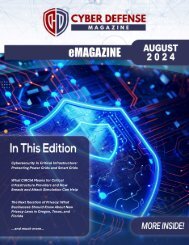Cyber Defense eMagazine June 2020 Edition
Cyber Defense eMagazine June Edition for 2020 #CDM #CYBERDEFENSEMAG @CyberDefenseMag by @Miliefsky a world-renowned cyber security expert and the Publisher of Cyber Defense Magazine as part of the Cyber Defense Media Group as well as Yan Ross, US Editor-in-Chief, Pieruligi Paganini, Co-founder & International Editor-in-Chief, Stevin Miliefsky, President and many more writers, partners and supporters who make this an awesome publication! Thank you all and to our readers! OSINT ROCKS! #CDM #CDMG #OSINT #CYBERSECURITY #INFOSEC #BEST #PRACTICES #TIPS #TECHNIQUES
Cyber Defense eMagazine June Edition for 2020 #CDM #CYBERDEFENSEMAG @CyberDefenseMag by @Miliefsky a world-renowned cyber security expert and the Publisher of Cyber Defense Magazine as part of the Cyber Defense Media Group as well as Yan Ross, US Editor-in-Chief, Pieruligi Paganini, Co-founder & International Editor-in-Chief, Stevin Miliefsky, President and many more writers, partners and supporters who make this an awesome publication! Thank you all and to our readers! OSINT ROCKS! #CDM #CDMG #OSINT #CYBERSECURITY #INFOSEC #BEST #PRACTICES #TIPS #TECHNIQUES
You also want an ePaper? Increase the reach of your titles
YUMPU automatically turns print PDFs into web optimized ePapers that Google loves.
several common attack vectors, VPNs limit operational flexibility in that they don’t allow for dynamic<br />
access based on conditions and user context.<br />
Make Secure Remote Access a Business Enabler<br />
For data center operators, maintaining building management systems is a non-negotiable requirement.<br />
Many data center operators are looking for an alternative to the VPN. The answer for many operators of<br />
sensitive industrial systems, including data centers, is the Software Defined Perimeter (SDP). One of the<br />
big advantages of SDP is the ability to enforce least privilege access to third-party support organizations.<br />
Unlike with a VPN, SDP can allow access to specific systems included in a contractor’s support<br />
agreement without giving them wide access to the network. As an example, the RF code wireless<br />
temp/humidity sensors in some data centers are supported by specialized service providers. Using SDP,<br />
CISOs can limit the contractor’s access to those servers without opening up our other BMS platforms.<br />
CISOs can also use SDP to ensure that the contractor’s machines meet security requirements before<br />
they connect. If the laptop is not sufficiently updated and protected by antivirus software, SDP will block<br />
the connection. These additional audit and security controls are a far superior solution than legacy VPNs.<br />
As data centers look to fortify their security posture, there is the realization that a full-scale overhaul isn’t<br />
economical. Incremental refreshes are, however, so as components and systems such as humidifiers or<br />
cooling systems are updated or replaced, cost, efficiency, and security must be paramount. Outmoded<br />
systems that require people onsite to run them open enterprises up to future vulnerabilities to threats that<br />
are known, unknown, or unforeseen — such as a pandemic.<br />
Designing ICS and data center systems that are naturally and organically configured for secure remote<br />
access produces a number of benefits. First, remote access can result in cost savings over on-site access<br />
requirements as the latter incur additional travel and head-count costs. Second, modern remote access<br />
tools improve security flexibility. Lastly, remote access allows for separation between operators and<br />
vendors that adds to resilience against operational interruptions caused by pandemics and natural<br />
disasters.<br />
Planning for the future means moving secure remote access toward the top of the list of criteria for IT<br />
investments. The world has changed dramatically. We must ensure our security solutions keep pace.<br />
About the Author<br />
Leo Taddeo, Chief Information Security Officer, Cyxtera Technologies and<br />
President, Cyxtera Federal Group, is responsible for oversight of Cyxtera's<br />
global security operations, investigations and intelligence programs, crisis<br />
management, and business continuity processes. He provides deep domain<br />
insight into the techniques, tactics and procedures used by cybercriminals, to<br />
help Cyxtera and federal agencies defend against advanced threats. Leo can<br />
be reached at @LeoTaddeoCZ? and at our company website<br />
https://www.cyxtera.com.<br />
<strong>Cyber</strong> <strong>Defense</strong> <strong>eMagazine</strong> –<strong>June</strong> <strong>2020</strong> <strong>Edition</strong> 28<br />
Copyright © <strong>2020</strong>, <strong>Cyber</strong> <strong>Defense</strong> Magazine. All rights reserved worldwide.


















